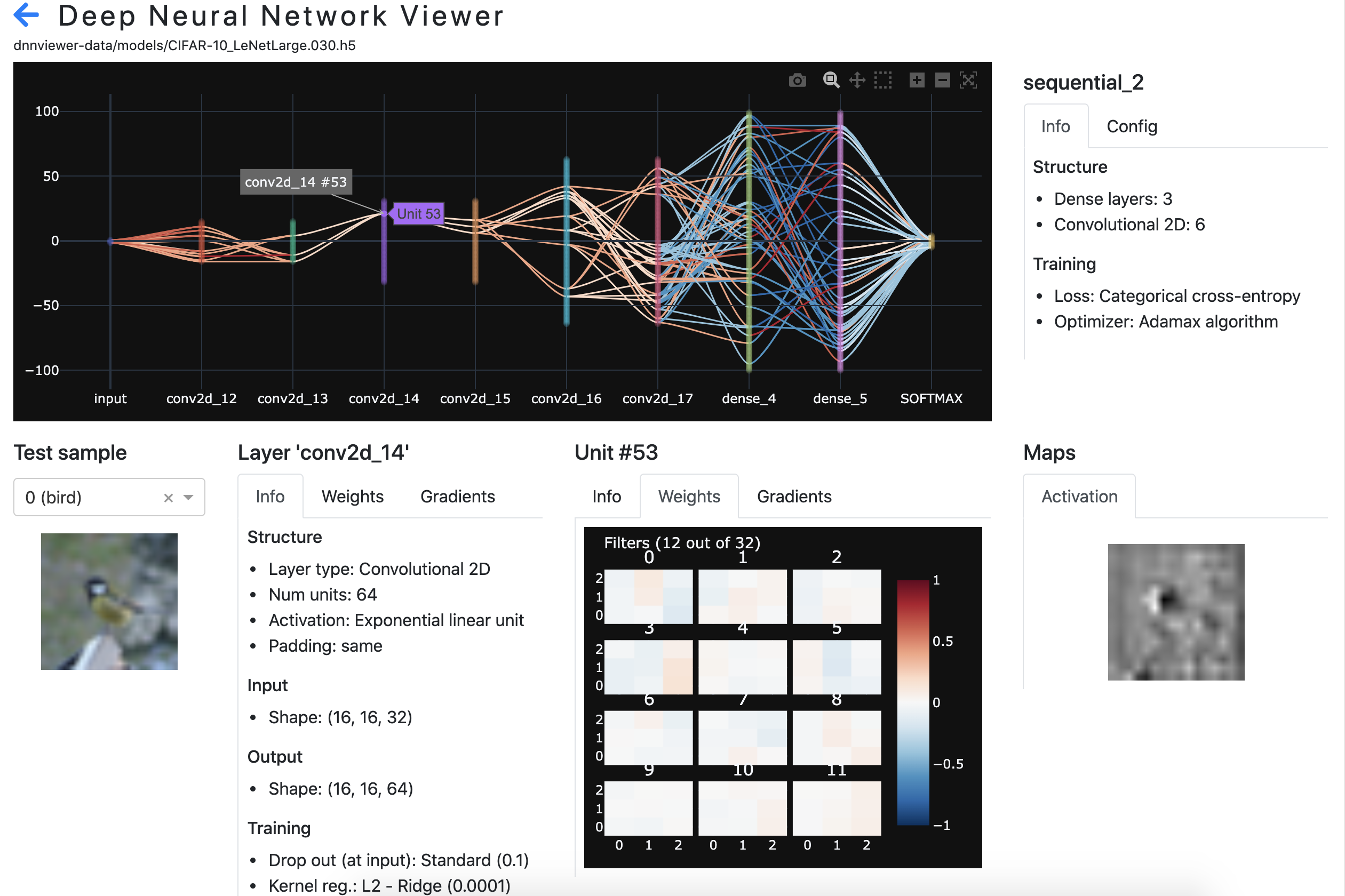Deep Neural Network viewer
A dashboard to inspect deep neural network models
DNN Viewer is providing interactive view on the layer and unit weights and gradients, as well as activation maps.
DNN Viewer is distinctive to existing tools since it is linking architecture, parameters, test data and performance.
Current version is targeted at the classification task. However, coming version will target more diverse tasks.
This project is for learning and teaching purpose, do not try to display a network with hundreds of layers.

Install
Install with PIP
```shell script $ pip install dnnviewer
Run `dnnviewer` with one of the examples below, or with you own model (see below for capabilities and limitations)
Access the web application at http://127.0.0.1:8050
# Running the program
Currently accepted input formats are Keras Sequential models written to file in Checkpoint format or HDF5. A series of checkpoints along training epochs is also accepted as exemplified below.
Some test models are provided in the GIT repository `_dnnviewer-data_` to clone from Github or download a zip from the [repository page](https://github.com/tonio73/dnnviewer-data), a full description of the models and their design is available in the repository [readme](https://github.com/tonio73/dnnviewer-data/blob/master/README.md).
```shell script
$ git clone https://github.com/tonio73/dnnviewer-data.git
Test data is provided by Keras.
Selecting the model within the application`
Launch the application with command line --model-directories that set a comma separated list of directory paths where the models are located
$ dnnviewer --model-directories dnnviewer-data/models,dnnviewer-data/models/FashionMNIST_checkpoints
Then select the network model and the corresponding test data (optional) on the user interface

Models containing the ‘{epoch}’ tag are sequences over epochs. They are detected based on the pattern set by
command line option --sequence-pattern whose default is {model}_{epoch}
Generating the models
From Tensorflow 2.0 Keras
Note: Only Sequential models are currently supported.
Save a single model
Use the save()method of keras.models.Model class the output file format is either Tensorflow Checkpoint or HDF5 based on the extension.
model1.save('models/MNIST_LeNet60.h5')
Save models during training
The Keras standard callback tensorflow.keras.callbacks.ModelCheckpoint is saving the model every epoch or a defined period of epochs:
from tensorflow import keras
from tensorflow.keras.callbacks import ModelCheckpoint
model1 = keras.models.Sequential()
#...
callbacks = [
ModelCheckpoint(
filepath='checkpoints_cnn-mnistfashion/model1_{epoch}',
save_best_only=False,
verbose=1)
]
hist1 = model1.fit(train_images, train_labels,
epochs=nEpochs, validation_split=0.2, batch_size=batch_size,
verbose=0, callbacks=callbacks)
Current capabilities
- Load Tensorflow Keras Sequential models and create a display of the network
- Targeted at image classification task (assume image as input, class as output)
- Display series of models over training epochs
- Interactive display and unit weights through connections within the network and histograms
- Supported layers
- Dense
- Convolution 2D
- Flatten
- Input
- Following layers are added as attributes to the previous or next layer
- Dropout, ActivityRegularization, SpatialDropout1D/2D/3D
- All pooling layers
- BatchNormalization
- Activation
- Unsupported layers
- Convolution 1D and 3D
- Transpose convolution 2D and 3D
- Reshape, Permute, RepeatVector, Lambda, Masking
- Recurrent layers (LSTM, GRU…)
- Embedding layers
- Merge layers
Developer documentation
See developer.md